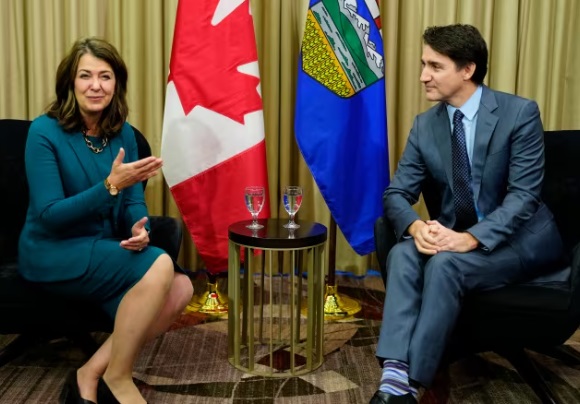Alberta
Before Trudeau Blames Alberta, Perhaps He Should Look in the Mirror

From EnergyNow.ca
There has been a lot of talk about how Premier Danielle Smith did not sign a statement of support with the Government of Canada regarding a unified response to any tariff action taken by incoming President of the United States, Donald Trump.
Trudeau singles out Alberta premier for not putting ‘Canada first’ in break with other provinces
Thanks for reading William’s Substack! Subscribe for free to receive new posts and support my work.
While it is easy to throw stones at Premier Smith and call her actions one of selfishness, placing the interests of Alberta ahead of Canada, I think there are a number of reasons why one could reply that she was well within her right to act as she did. Over the last decade, Trudeau has gone out of his way to vilify the oil and gas industry, through his continual bad mouthing of the industry as being antiquated, and implementing policies that ensured that capital flight from the space accelerated, infrastructure projects were cancelled and massive levels of uncertainty were overlaid on the investment landscape going forward. Despite all this, the oil and gas sector still remains one of the most important economic contributors to the economy and is the largest component of exports from Canada to the United States, and it isn’t even close.

The Observatory of Economic Complexity (OEC)
The ironic thing of all this? To get oil to the refineries in the east, you need to IMPORT it by pipeline from the United States or primarily by ship to Quebec and New Brunswick. Had the Energy East Pipeline been built, Canadian refineries could have had Canadian domiciled product to satiate them. Moreover, had Northern Gateway been built, we would have diversified our client list beyond the United States. Sure, the Trans Mountain Pipeline was built, at extraordinary cost and timelines, and some “credit” is due to the Government getting it done, but the proof is in the current landscape that we operate in.

Now, coming back to the beginning. Why do I think Trudeau should look in the mirror before throwing rocks at Premier Smith? I come back to 2015 when Trudeau said Canada is the world’s “first postnational state” and that “there is no core identity, no mainstream in Canada.” He has gone about taking away what many of us grew up with, namely a sense of Canadian identity, and tried to replace that with shame and no collective identity. What is a post nation state you may ask? Post-nationalism or non-nationalism is the process or trend by which nation states and national identities lose their importance relative to cross-nation and self-organized or supranational and global entities as well as local entities.
So, is it any wonder that people are starting to question what is Canadian any more? At a time when Canada is under significant threat, the irony that Alberta likely represents the best tool in this tools (Trudeau) economic toolbox, is wildly ironic. As they say, karma’s a bitch.
Thanks for reading William’s Substack! Subscribe for free to receive new posts and support for his work.
Alberta
From Underdog to Top Broodmare

WATCH From Underdog to Top Broodmare (video)
Executive Producers Jeff Robillard (Horse Racing Alberta) and Mike Little (Shinelight Entertainment)
What began as an underdog story became a legacy of excellence. Crackers Hot Shot didn’t just race — she paved the way for future generations, and in doing so became one of the most influential producers the province has known.
The extraordinary journey of Crackers Hot Shot — once overlooked, now revered — stands as one of Alberta’s finest success stories in harness racing and breeding.
Born in humble circumstances and initially considered rough around the edges, Crackers Hot Shot overcame long odds to carve out a career that would forever impact the province’s racing industry. From a “wild, unhandled filly” to Alberta’s “Horse of the Year” in 2013, to producing foals who carry her spirit and fortitude into future generations.
Her influence ripples through Alberta’s racing and breeding landscape: from how young stock are prepared, to the aspirations of local breeders who now look to “the mare that did it” as proof that world-class talent can emerge from Alberta’s paddocks.
“Crackers Hot Shot, she had a tough start. She wasn’t much to look at when we first got her” — Rod Starkewski
“Crackers Hot Shot was left on her own – Carl Archibald heard us talking, he said ‘I’ll go get her – I live by there’. I think it took him 3 days to dig her out of the snow. She was completely wild – then we just started working on her. She really needed some humans to work with her – and get to know that people are not scary.” — Jackie Starkewski
“Crackers Hot Shot would be one of the top broodmares in Albeta percentage wise if nothing else. Her foals hit the track – they’re looking for the winners circle every time.” — Connie Kolthammer
Visit thehorses.com to learn more about Alberta’s Horse Racing industry.
Alberta
Province orders School Boards to gather data on class sizes and complexity by Nov 24

Better data, better outcomes for Alberta students |
To help schools address classroom complexity, Alberta’s government will begin collecting annual data on class size and composition.
Over the past three years, Alberta has welcomed more than 80,000 new students. With this unprecedented growth, classroom complexity and class sizes are among the biggest issues facing schools and teachers across the province.
To meet this challenge head on, Alberta’s government will work with school boards to gather yearly data on class sizes and composition. This information will be used to better understand staffing, student needs and classroom complexity. School boards will be required to submit data on Alberta classrooms by Nov. 24, and by January, this data will be made publicly available and will then be released annually.
Data collected on classroom complexity will help the province understand and address issues in schools, including class sizes, and support strategic investments in classrooms. Over the next three years, school boards will be provided with funding to hire 3,000 teachers and 1,500 new education assistants to support students with complex needs.
“We are ready to work with school boards and teachers to address classroom complexity and class sizes. We have heard them loud and clear and we are taking bold action to address these issues.”
Alberta’s government is establishing a Class Size and Complexity Task Force to begin work immediately on identifying solutions to the challenges facing Alberta classrooms. Alongside new annual data collection, the task force will ensure every student gets the attention and support they need to succeed. Details about the task force will be shared in the coming weeks.
“This data will provide essential insight into classroom realities, guiding evidence-based decisions and advocating for sustainable funding to address complexity, ensuring every student and educator in Alberta has the support to thrive.”
Quick facts
To inform decisions on addressing classroom complexity, data will be collected on total numbers of:
- all staff, per school, including roles
- substitute teachers
- district staff, listed by job title
- students, per classroom, per school
- severe, mild/moderate, and gifted/talented students, per classroom, per school
- English as an additional language (EAL) students, per classroom, per school
- refugee students, per classroom, per school
- First Nations, Métis and Inuit students, per classroom, per school
- Individualized Program Plans, per classroom, per school
- students waitlisted for assessment, per classroom, per school
- incidents of aggression and violence
- $55 million was provided in Budget 2025 to address classroom complexity.
- 8.6 billion is being invested to build and renovate more than 130 schools across the province.
- Budget 2025 is investing $1.6 billion in learning support funding to help meet students’ specialized learning needs.
- Budget 2025 is investing $1.1 billion to hire more than 4,000 teachers and educational staff.
-

 Crime1 day ago
Crime1 day agoCanada Seizes 4,300 Litres of Chinese Drug Precursors Amid Trump’s Tariff Pressure Over Fentanyl Flows
-

 Alberta19 hours ago
Alberta19 hours agoFrom Underdog to Top Broodmare
-

 Alberta1 day ago
Alberta1 day agoHow one major media torqued its coverage – in the take no prisoners words of a former Alberta premier
-

 Bruce Dowbiggin2 days ago
Bruce Dowbiggin2 days agoGet Ready: Your House May Not Be Yours Much Longer
-

 Alberta1 day ago
Alberta1 day agoProvince orders School Boards to gather data on class sizes and complexity by Nov 24
-

 Business2 days ago
Business2 days agoCanada’s attack on religious charities makes no fiscal sense
-

 Business2 days ago
Business2 days agoWhen Words Cook the Books: The Politics of ‘Investment-Speak’
-

 Opinion1 day ago
Opinion1 day agoBill Gates Shakes Up the Climate Discussion




